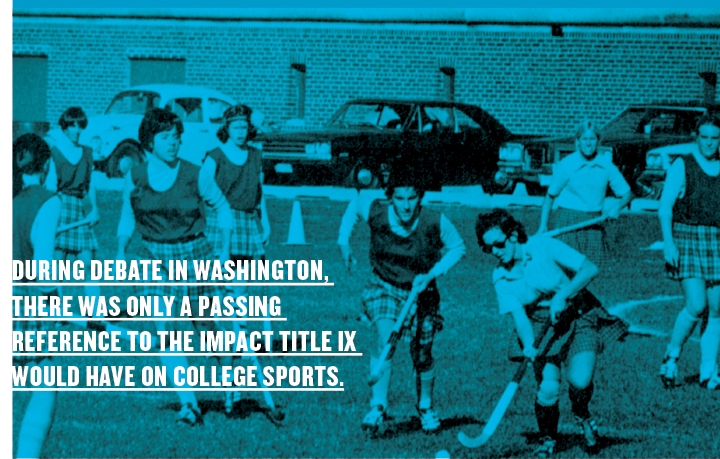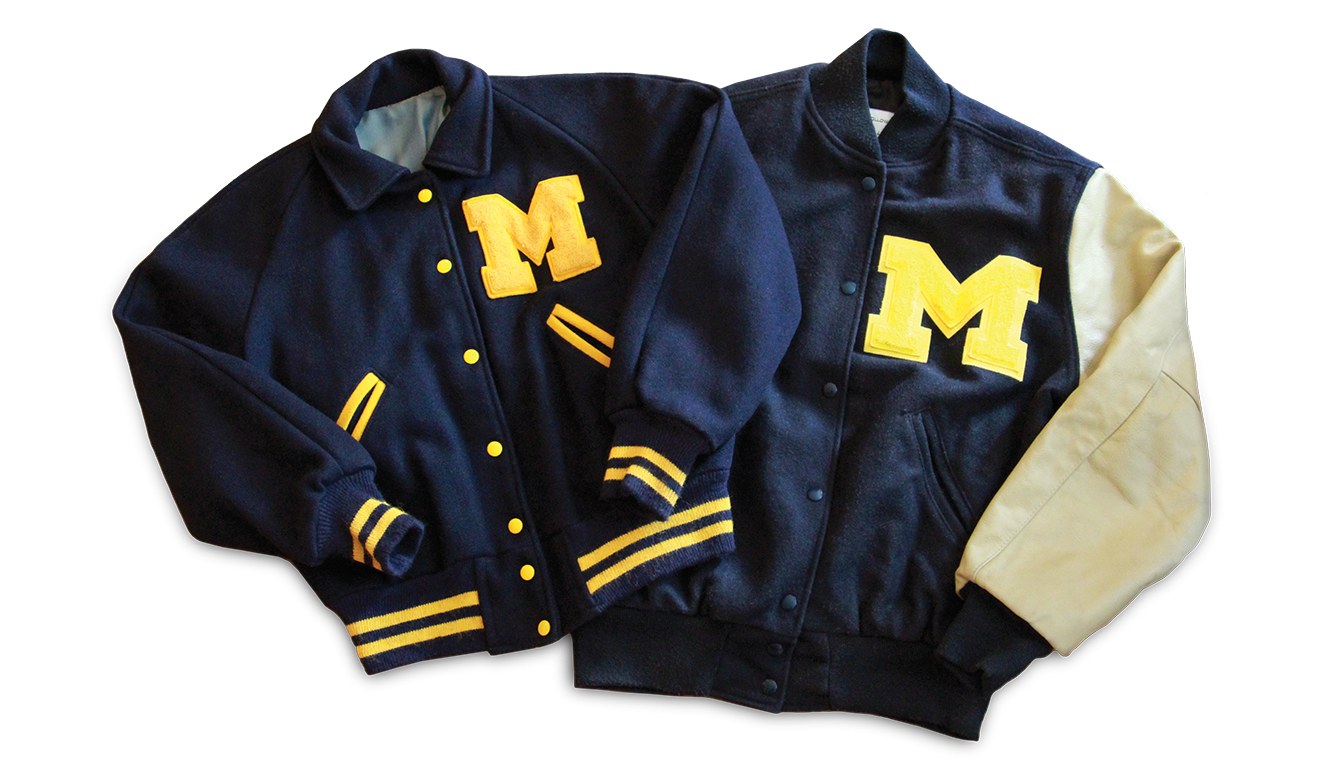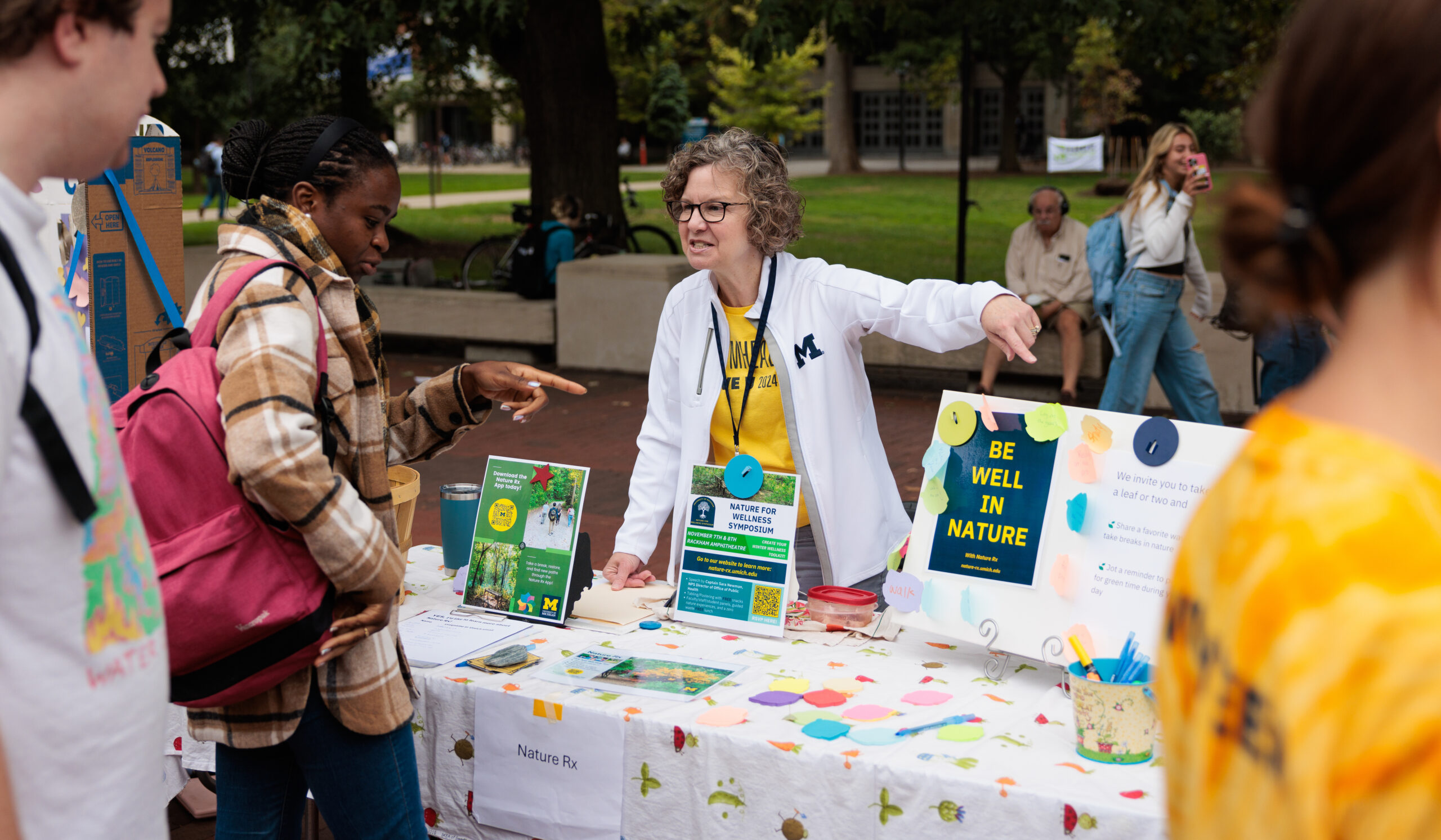As the manager of the Michigan women’s field hockey club in the early 1970s, Sheryl Szady, ’74, MA’75, PhD’87, had a scheduling routine. Every spring, she contacted coaches at colleges around the state to find out when Michigan could play their teams the following season and slot the games into the lineup.
But as she was planning for the 1973-74 season, Szady got a puzzling response. “They would say, ‘not this year, not this year,’” Szady says. “Finally, the Eastern Michigan coach called and said, ‘We blacklisted Michigan until somebody changes the program.’”
The change, Szady learned, meant elevating the women’s club team to varsity level. The phone call set in motion an effort to win recognition for women’s sports that led from U-M students to administrators and finally to a supportive member of the board of regents who was a pioneer in her own right. In the fall of 1973, their efforts culminated in the initial creation of six varsity-level sports for women: basketball, field hockey, swimming and diving, synchronized swimming, tennis, and volleyball.
In 2017, Michigan women compete on 14 varsity teams, playing under regulations drafted by the National Collegiate Athletic Association. But in 1973, the NCAA did not oversee athletics for women at its member schools. The women’s programs fell under the jurisdiction of the State of Michigan Association of Intercollegiate Athletics for Women (SMAIAW), the Michigan branch of a national organization.
At the time, confusion reigned on university campuses over congressional approval of Title IX of the Education Amendment Act in 1972. Title IX, as it became known, banned sexual discrimination in federally funded education. During debate in Washington, there was only a passing reference to the impact it would have on college sports, says Christine Grant, the retired women’s athletic director at the University of Iowa and a nationally known expert on Title IX.
“Universities knew it was going to affect academics. Nobody knew it was going to affect athletics,” Grant says. “I can tell you it raised the hairs on the back of the necks of athletic directors across the country.” Michigan, like many schools, waited to implement guidelines concerning college athletics immediately after Title IX’s passage because it was unclear what the statute would mean.
“Most of the other universities in the country were doing exactly the same thing. Michigan was not behind,” Grant says.
Szady discovered that the Michigan schedule boycott did not stem from tardiness over Title IX, but from a ruling by the SMAIAW. In early 1973, it mandated that the state’s universities raise their women’s club teams to varsity level, Szady says. The problem was, “they didn’t tell us,” meaning the individual teams. Frustrated that she couldn’t craft a field hockey schedule, Szady appealed to Henry Johnson, then-vice president of student services.
“I said, ‘We need some help. Nobody will play us.’” To illustrate the problem, she prepared a chart comparing the SMAIAW’s mandate, the situation the Michigan women were in, and what they wanted, namely, varsity status.
Johnson promised to get her an appointment with Robben Fleming, University president at the time, to discuss the matter. He subsequently called back and said, “I can’t get you on Fleming’s calendar, but you’re going to talk to the board of regents,” Szady recalls.
Daunted by the idea of appearing at the regents’ long meeting table, Szady turned to Margaret Laird, ’45, the mother of student athlete Linda Laird, ’74. Linda had agreed to present to the regents alongside Szady. Her mother—who was well-versed in the workings of the University—told them, “You’re going to talk to Trudy Huebner first.” When Szady asked why she needed to speak to the lone female regent, Laird replied, “You need a test run. And, more importantly, you need to have somebody (on the board) in your pocket.”
Gertrude Huebner, ’36, was elected as a Republican to the board of regents in 1966. A prominent advertising executive in the “Mad Men” era, she came up with the slogan “Indescribably Delicious” for the Mounds candy bar and crafted ads for companies such as Gillette, Heinz, and Chung King.
Serving as a regent from 1967 through 1975, Huebner delighted in her duties at Michigan, which she attended in the 1930s on a full scholarship, and remained interested in University affairs long after she left the board.
“She was always outspoken, very direct, likeable, never abrasive,” recalls William Milliken Jr., an Ann Arbor realtor and longtime friend who served with her on the board of Republic Bancorp.
Huebner’s grandson, Eric DeLamarter, ’02, wasn’t surprised to hear his “Grandma Trudy” took up the women athletes’ cause. “She would have these solutions that seemed so simple,” he says, “but other people wouldn’t think of them.”

The week before Szady’s presentation to the April 1973 regents’ meeting, Szady, Linda, and Huebner met for a practice session at Inglis House, Michigan’s residence for visiting dignitaries. Huebner listened closely to their presentation, giving the two young women advice on what to emphasize in the meeting.
Nodding approvingly at the end of the session, Huebner said, “You’re good to go,” Szady recalls.
The evening before the presentation to the regents, Szady and Linda left a copy of their presentation in the mailbox of Michigan athletic administrator Marie Hartwig, long an advocate for women athletes, alerting her to the impending meeting. To their delight, Hartwig—now best known on campus as the namesake of the athletic department’s administration building—showed up the following day at the regents’ meeting, flanked by two colleagues, in a powerful show of support for their cause.
The regents were known for giving presenters only five minutes of their time, not a moment longer. A group of casually dressed students who preceded Szady and Linda on the agenda got exactly that much attention, so Szady was prepared to talk quickly. Clad in a pink pantsuit, alongside Linda, who had also dressed up for the occasion, Szady began by asking, “Can you help us?” The regents leaned in; the pair were allowed to speak for 45 minutes, their clean-cut appearance, Szady believes, giving their presentation a professional advantage.
At the end, Fleming asked, “What do we do about this?” Huebner spoke right up. “There’s Marie Hartwig; let’s ask her.”
By May, Fleming had established the Committee to Study Intercollegiate Athletics for Women (chaired by local community leader Eunice Burns, MPA’70) to review the status of women athletes on campus. By June, the Burns Committee recommended that the six teams (including Szady’s field hockey club) be given varsity status, and Hartwig was named the first associate athletic director for women’s athletics.
Szady still marvels at how quickly things happened. “This was like a land speed record.”
Implementation, however, came much more slowly. The U.S. Department of Health, Education, and Welfare investigated the University in the late 1970s for its alleged inequity in athletics, including the perception that women did not get as much coaching time as men in the same sports, and Michigan did not fully comply with Title IX in terms of scholarships for women until 1989. (For more on how Szady recently helped right another wrong, see the sidebar “The Jacket Issue.”)
But the bond between Szady and Huebner remained in place. In 1987, Szady walked across the stage at Michigan Stadium to receive her doctorate in higher education. After she picked up her diploma, she found her path blocked by Huebner, who was a guest on the platform.
“You didn’t tell me you were graduating!” exclaimed Huebner, hugging her in front of the entire stadium crowd.
The Jacket Issue
By Sheryl Szady, ’74, MA’75, PhD’87
While watching a Michigan volleyball match in October 2015, I was pleased to see Jim Hackett, ’77, U-M’s new interim athletics director, enter to watch the match from the far portal. At intermission, I joined the throng surrounding Jim, who was graciously working the crowd when I approached. After I shook his hand and introduced myself, he reciprocated and moved forward—but I didn’t let go of his hand.
“I’m the one who wrote you about the letter jackets,” I said. Jim looked at the next person in the crowd and excused himself, moving with me into the hallway for a 10-minute chat about the “jacket issue.” I had responded in July 2015 to his email announcing the elaborate celebration of 150 years of Michigan Athletics with words of congratulations. I also wrote that it was time to right a wrong.
When female athletes first received varsity jackets in 1973, we were surprised to see them adorned with a small, orange Block M, rather than the larger, lemon-yellow initial displayed on the men’s varsity jackets. I immediately contacted numerous administrators to request the same Block M as the men’s jackets. The request repeatedly fell on deaf ears. Thus, the women letter winners from fall 1973 through spring 1991 were issued varsity jackets with a different Block M.

In the fall of 1991, the department started issuing identical varsity jackets with the proper maize Block M to both the women and men. The early letter winners, however, did not get them and remained “small M” jacket holders. Every subsequent athletic director and many administrators I approached all declined to right this wrong—until I held onto Jim Hackett’s hand.
He got the ball rolling and encouraged me and Bob DeCarolis, senior adviser to the athletic director and spouse of an early woman letter winner, to develop a presentation to the department’s executive group. However, I was dismayed to hear shortly afterward that Jim would be stepping down as athletic director in December 2015. The jacket project presentation was delayed once, then twice, then into the New Year. The search for the new athletic director clouded the status of the project.
In March 2016, former U-M football player and Michigan Athletics staffer Warde Manuel, ’90, MSW’93, MBA’05, became the new athletic director. As fate would have it, I spotted him as I exited a women’s basketball game at Crisler. It was time for another introduction. Although we had met previously when he was on staff, I wasn’t sure if he would remember me. I didn’t need to worry.
“Sheryl!” he exclaimed, giving me a hug.
I thought, “This is good!” But the conversation was even better:
“I’ve been reading your research.”
“About the jackets?”
“Yes!”
“Are we going to do them?”
“Definitely!”
“Thank you!”
Long story short, on April 5, Warde’s gracious letter offered the following: “As one of Michigan’s varsity pioneers, having earned a varsity letter between 1973 and 1991, the athletic department is thrilled to offer you a new varsity jacket—the same jacket supplied to Michigan men and women since 1992.”
Righting the wrong. Ultimately, 900 women received the offer of a new jacket.
When the jackets started arriving on doorsteps in July 2016, I asked the Jacket Gals to post pictures of themselves in their new jackets on the Facebook group Michigan Early Women Letterwinners. The response was amazing as Jacket Gals saw their teammates, roommates, and classmates for the first time in 30-40 years. They expressed their appreciation for the jackets and for the appropriate recognition from the University.
When Warde helped me into my new jacket for the first time, it was a wonderful moment—finally. Then I realized that 812, by current count, of 900 other Jackets Gals were sharing the same feelings. Awesome!
Micheline Maynard is a contributor to Forbes and served as the senior editor with the NPR program “Here & Now.” She was a Knight-Wallace Fellow at U-M in 1999-2000.
An earlier version of this story incorrectly attributed Margaret Laird’s quotes to Marie Hartwig. We also misstated the month when the Burns committee was first established (it was May 1973, not August), and the month the committee delivered their recommendation (it was June 1973, not November).





